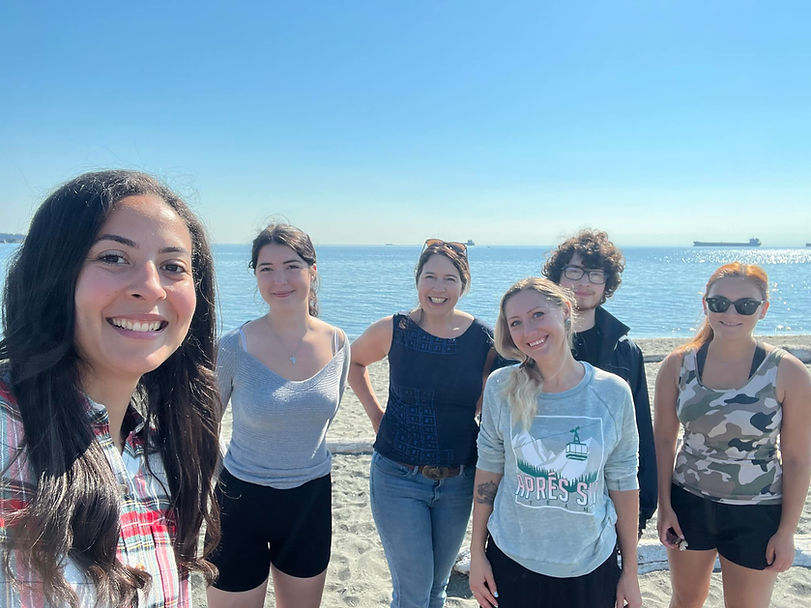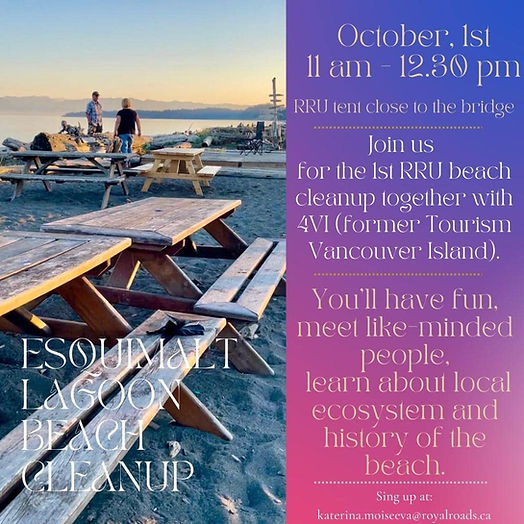
Esquimalt Lagoon | Katerina Moiseeva | Rebecca WilsonMah
Poster-announcement

Esquimalt Lagoon | Katerina Moiseeva
Pitch video that I cut into small chunks and posted on relevant social media pages.
Before the beach cleanup
In preparation for the beach cleanup. I reached out to instructors from Royal Roads University School of Tourism, who advised to label it as "the 1st Royal Roads beach cleanup”. I contacted RRU's Student Engagement Services for extra support. Initially, we discussed setting up an RRU tent on the beach for storing cleanup equipment and distributing event brochures. Considering the limited three-week timeframe and the necessity to involve local authorities in this case, we decided to make it simple and not to install a tent.
I created a poster and a video inviting RRU students to join the cleanup, which I shared across my social media platforms, using relevant hashtags.
During my pitch, I highlighted the social aspect of beach cleanups as a way to forge new friendships among fellow students, gain insights into the local area (the beach is visible from RRU) and contribute positively to the community—a concept that many newcomers and foreign students like us are relatively new to. I emphasized that, given our diverse cultural backgrounds, this event presented an opportunity to learn about and engage with local life while expanding our social networks. While the primary goal was cleaning the beaches and preventing toxic waste from entering the ocean, fostering connections and community engagement came first.
Drawing from my past cleanup experiences, I purchased buckets for glass waste, large garbage bags, a "trash picker," gloves, a substantial water bottle, and reusable glasses. I set up a small table and arranged all the supplies neatly, complete with a speaker playing music.
Before selecting Esquimalt Lagoon for the cleanup, I scouted the area to estimate the pollution level, which appeared relatively high. However, there were some surprises on the actual cleanup day.
During the beach cleanup
Participants
Modestly, seven people joined the cleanup effort, with the majority being RRU students, and one participant bringing a friend. Anna, an exchange student from Austria, was eager to experience the local vibes of Vancouver Island and share them back home.
Leo, a student majoring in Environmental Studies, proved to be a valuable addition to our group. He surprised us with fascinating tales about the shore and the various ocean species inhabiting Esquimalt Lagoon. Leo identified the origins and roles of the plants and rocks at the beach, as well logs washed ashore. His storytelling was so captivating that it attracted a circle of beachgoers eager to hear more about the local beach and its ecology.
We also learned about the unique spit formation at Esquimalt Lagoon, which is natural but requires periodic maintenance.
Competition
As we began cleaning the beach, we noticed a friendly competition unfolding. Two independent companies were conducting their own cleanups that weekend. As one of the participants mentioned, cleaning the beach had become a regular weekend pastime for many locals, akin to spending quality time. This observation echoed similar experiences during other cleanup events. Local residents would casually stroll with their dogs or pass by with a waste bag in hand, emphasizing that the beach was like their backyard and their responsibility to maintain.
Atmosphere
The weather was ideal - sunny with no wind. People relaxed as they strolled along the shore, with children, dogs, couples, and groups of friends enjoying the beautiful day. Following the cleanup, we sat on logs, listened to music, snacked, and soaked in the sun. It was a peaceful and rewarding experience, and someone from our group mentioned that it would have been really sad to spend such a day alone. This highlights one of the benefits of community cleanups: they are not just about cleaning but also about connecting with others.
It's an opportunity to forge new friendships, spend quality time at the beach, enjoy the weather and scenery, and acquire new knowledge.
 |  |  |  |
|---|---|---|---|
 |  |


Esquimalt Lagoon | Katerina Moiseeva
Garbage at Esquimalt lagoon
A regular beachgoer who frequently visited the area noted that people today are more responsible than in the past. Some of the garbage came from cruise ships or was windblown from vehicles, tables, food trucks, or overflowing trash containers. We also the issue of crows, which would empty trash bins and scatter the garbage across the shore.
In total, we collected five bags of plastic and paper, a bucket of broken glass and bottles, and one full bucket of cigarette butts. I took all the collected garbage home to sort it for recycling, but larger events typically partner with recycling companies. I recorded our cleanup data in the "Marine Debris Tracker" app, documenting the items we collected and the length of shoreline we cleaned.
To add an element of fun to the event, we shared the most unusual items we discovered. The trail of garbage often tells intriguing stories. Some peculiar finds were a half-full bottle of Bacardi rum (which, of course, we did not take home), a lone shoe, a hanger, and a few socks. Yes, we ensured that a lone shoe and socks didn't belong to swimmers enjoying the sunny day, as that would have caused quite a confusion.
Testimonials
"Ha, we've got to ensure this rogue sock isn't trying to swim with the fishes!"
"Wow, that was quite the cardio session – up and down, non-stop!"
"Esquimalt Lagoon beach? It's like an open-air gallery. Folks craft wooden sculptures from beach finds, turning trash into treasure. The art here is astonishingly authentic. My personal favorite? A charming family of crows. How about you?"
Top garbage found
Cigarette butts and paper napkins were the most prevalent items we collected. Cigarette butts were mostly found in the parking lot, where drivers would thoughtlessly empty their car ashtrays onto the ground. Unfortunately, wind gusts carried these butts into the water, contributing to ocean pollution. Shockingly, just one hour of exposure can contaminate almost 8 liters of water with hazardous chemicals. Paper napkins were often carried away by the wind from nearby food trucks. The powerful winds at Esquimalt Lagoon could be quite intense.

These efforts may not provide an immediate, transformative change, but their cumulative effect is substantial in promoting a cleaner, healthier environment.
After the cleanup
After the event, I diligently recycled the collected garbage, wrote a post on social media, sharing reflections on our "quality time" together. I also pondered what could be improved for future events. Better event promotion and collaboration with a recycling company to provide a designated disposal point for sorted garbage would be beneficial. Like targeting beaches in a big need of cleanup, but being remote and challenging to access, this would require assistance from professional organizers.
Reflections
One cleanup day may not drastically transform the environment, but it contributes to a collective effort to reduce plastic and paper napkin usage – especially when we witness firsthand how much of it litters the beach. During our cleanup, we engaged in a thoughtful discussion about consumerism, recognizing how companies often push us to consume more and more. It led us to question the necessity of constantly acquiring new clothes or phones. Changing these habits is indeed a challenge, but when you see the tangible result of consumerism on such a large scale, it deepens your understanding of the issue compared to just reading about it.
We pledged to be more mindful of our waste, increase recycling efforts, and pause to consider the necessity of new purchases. When we returned home, we shared our small revelations and concerns with others, sparking a positive chain of knowledge-sharing.
Personal involvement in the problem allows for a profound understanding of its severity. While small steps lead to incremental changes, collectively, these small steps can make a tremendous difference.